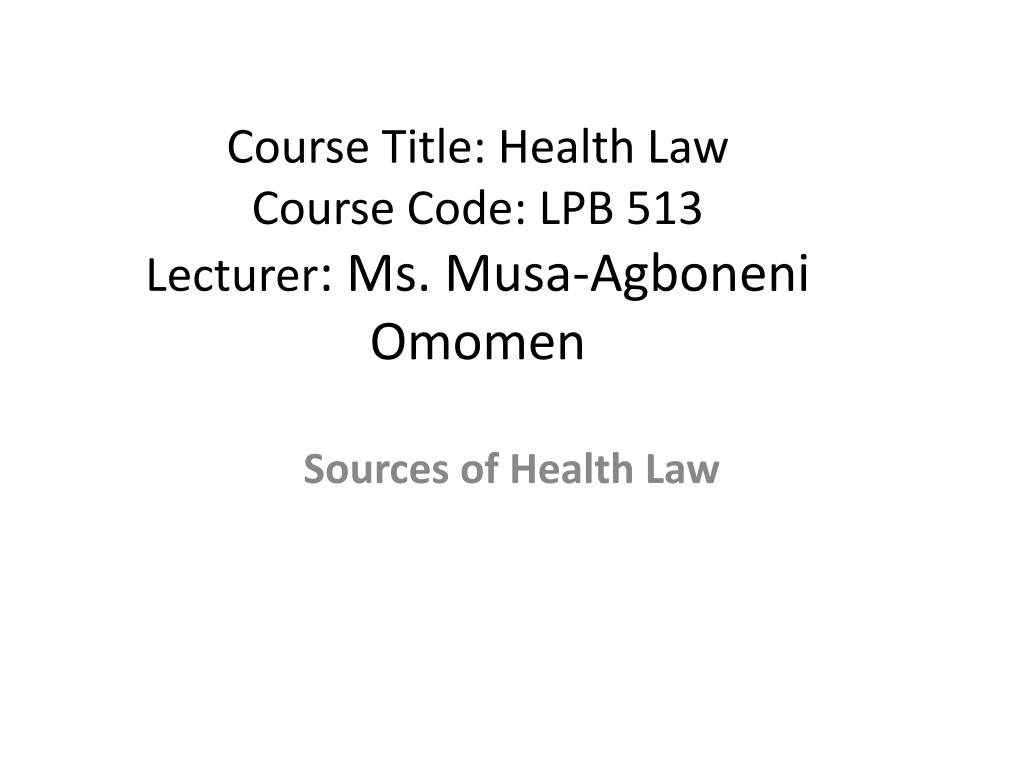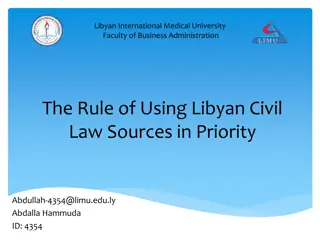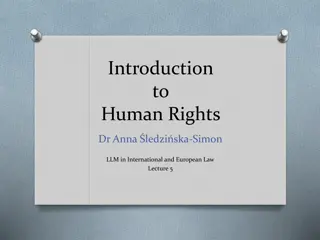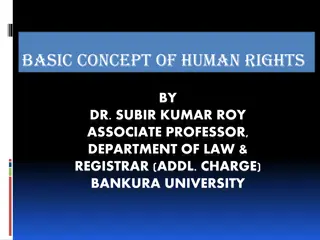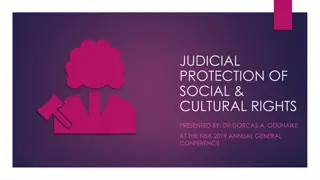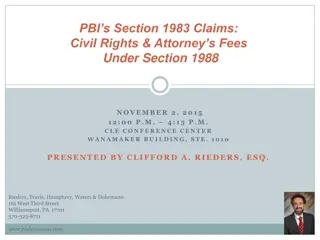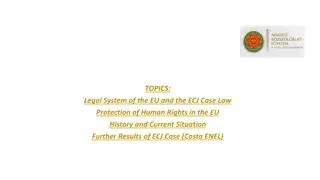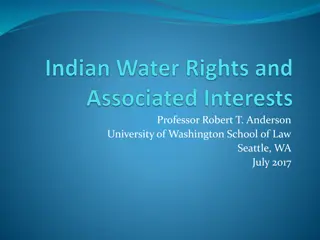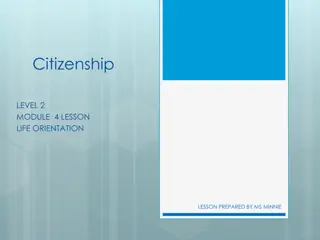Understanding Sources and Rights in Health Law
Exploring the sources of health law, this course delves into national laws governing health practices, including constitutional rights and regulations. Learn about the legal framework shaping healthcare systems and the importance of upholding health rights under the law.
Download Presentation

Please find below an Image/Link to download the presentation.
The content on the website is provided AS IS for your information and personal use only. It may not be sold, licensed, or shared on other websites without obtaining consent from the author. Download presentation by click this link. If you encounter any issues during the download, it is possible that the publisher has removed the file from their server.
E N D
Presentation Transcript
Course Title: Health Law Course Code: LPB 513 Lecturer: Ms. Musa-Agboneni Omomen Sources of Health Law
Learning out comes Students should be able to define health law. Students should to be able to identify and explain national sources of Health law
Sources of law are the origins of laws, the binding rules that enable any state to govern its territory. The term "source of law" may sometimes refer to the sovereign or to the seat of power from which the law derives its validity. Law is concerned with health and its regulation because it is a means of protecting the collective public interest. Health law can be defined as the laws, rules, regulations among providers to the health care industry and its patients.
World Health Organization defined Health as Health is a state of complete physical, mental and social well-being and not merely the absence of disease or infirmity. Health law is concerned with the regulation of all health professionals, not simply doctors. Government should determinants of health such as, provision of adequate education, good governance, housing, food, employment and favourable working conditions. also tackle the
The National sources of Health Law in Nigeria are as follows: *The Constitution *Contract Law *Torts Law *Criminal Law *Case Law
The Constitution: The Constitution of the Federal Republic of Nigeria 1999(as amended) is one of the sources of health laws. The constitution is the grund-norm through which every other law derives its validity and extent of authority. Section 1 emphasizes the supremacy of the constitution. Chapter IV Human Rights: Every human being has certain fundamental rights which every individual and government must uphold Government is responsible for achieving better health through respecting, protecting and fulfilling rights. and respect. The
Health rights under the constitution: i. The right to life section 33(1)of the Nigerian Constitution. A patient has a right not to have his life taken by any person including a health care provider. The health care provider must take absolute care when treating the patient and must ensure that death does not result as a consequence of such treatment. Medical doctors violate the right to life when they are negligent to their patients and perform acts like; Errors in treatment. See Chin Keow v. Government of Malaysia [1967] I.W.L.R. 813 Non removal of foreign objects inserted into a patient during surgery (See Chasney v Anderson [1950] 4 DLR 223) Failure to advice patients of substantial risks. See Rogers v Whitaker [1992] 175 CLR 479 Improper diagnosis, among others
A patient must not be subjected to medical experiment with the effect of causing the death of the patient. Rule 31(a), Code of Medical Ethics Euthanasia/Mercy killing- Rule 68, Code of Medical Ethics Here are so many challenges which affects the right to life of Nigeria s citizens. -Health care system - Traditional practices e.g Female Genital Mutilation - Armed conflict/Violence -Poverty - Child abuse
ii. The Right to Dignity Section 34(1)(a) of the Constitution - Every individual is entitled to respect for the dignity of his person, and accordingly, no person shall be subject to torture or to inhuman or degrading treatment. Right to dignity is an acknowledgment of the worth of human beings: human beings are entitled to be treated with respect and concern. A person must not be treated in a cruel, inhuman or degrading manner. Terminally ill patients are entitled to humane medical care so as to make dying as dignified and comfortable as possible Treated in a dignified manner no matter the state of his health e.g. HIV positive patients. See Hoffmann v South African Airways (cct17/00) [2000] ZACC 17) Torture- Rule 67, Code on Medical Ethics The notion of consent is also based on the fundamental principle of the dignity of an individual whose body shall not be touched without his or her approval.
iii. Right to freedom of thought, conscience and religion. Section 38(1), 1999 Constitution - Every person shall be entitled to freedom of thought, conscience and religion, including freedom to change his religion or belief, and freedom to manifest and propagate his religion or belief. A patient has the right to make decisions concerning treatments procedures by medical doctors. For example; a patient has a right to refuse to be treated and the medical officer has to respect such wishes. See Medical and Dental Practitioners Disciplinary Tribunal V Dr. John E. N. Okonkwo (2001) 2 MJSC 67. See Rule 39, Code of Medical Ethics An individual should be left alone to choose a course for his life, unless a compelling overriding state interest justifies the contrary. iv.Right to Privacy Section 37 of the Constitution provides that the privacy of citizens, their homes, correspondence, telephone conversations and telegraphic communications is guaranteed and protected. Information are not to be divulged Medical records are not for public consumption Rule 44, Code of Medical Ethics
Justifications for confidentiality -Consequences for the future relationship - Attainment of people s better health, welfare, the general good and overall happiness. Exceptions - Crimes See Hunter v Mann [1974] QB 767 at P 772 - Informed consent of the patient -Statutory notification of disease (Data could however be anonymised) 2. LAW OF CONTRACT A contract is defined as an agreement which the law will enforce or recognize as affecting the legal rights and duties of the parties. The doctor patient relationship is based on a contract, which is a voluntary agreement between the parties. The medical practitioner would not have any duty to that patient until a relationship is voluntarily established.
A contract may be created by the conduct of the parties. When a person requests medical examination or treatment, and the doctor begins to examine or treat that person, a contract has been created in the eyes of the law. Once the relationship is voluntarily formed, the relationship is governed by the law of contracts. This physician/patient relationship or contract is necessary for a number of other actions to occur or continue: - Subsequent treatment of the patient by the physician; - The right to physician/patient confidentiality; - The patient s ability to sue the physician in the case of alleged medical malpractice. Health Law Before a contract can be seen as valid, consent must have been obtained from the patient. See Rule 19 of the Code of Medical Ethics Such consent however, will not protect a surgeon from liability for negligence in the course of the procedure or going beyond the consent given unless the treatment creates an emergency situation in which consent to the additional procedures cannot be obtained immediately. For consent to be real, it must not have been obtained by fraud, deceit, intimidation, threat, duress, hypnotism or overpowering drugs. See R v Flattery (1877) 2 QBD 410 The law requires that a party to a contract has capacity to enter a contract. A person is defined as lacking capacity if he is unable to make a decision for himself due to an impairment of the functioning of the mind or brain. See Re MB (An Adult: Medical Treatment) (1997) 2 FCR 541, 553 4. Most malpractice suits against health care providers are based on tort law, not on contract.
One type of malpractice case based on contract law is the claim that the physician promised a certain outcome that was not achieved. If the physician is incautious enough to make a promise, the law will sometimes enforce it. Guilmet v. Campbell 385 Mich. 57, 188 N.W.2d 601 (1971). A breach of contract suit can also arise from failure to use a promised procedure. See Stewart v. Rudner & Bunyan, [1957] 349 Mich. 459, 84 N.W.2d 816 and Nicoleau v. Brookhaven Mem. Hosp [1994] 201 A.D.2d 544, 607 N.Y.S.2d 703. Damages for breach of contract are not intended to compensate the patient for injuries suffered but rather to put him in the position he would have been if the treatment was properly performed To raise liability, the patient will need to prove the following; 1. The contract/doctor-patient relationship 2. The breach of contract 3. Link between the injury and the treatment 4. Damages 3. TORT LAW Tort law is the field of civil law that determine the rights and responsibilities that individuals and organizations, owe one another. While the duty in contract arises from the agreement between the parties, that in tort is independent of agreement and imposed upon the parties by Law. A suit for breach of duty against health care professionals is governed by tort law principles. In bringing an action to courts under the law of torts, the following has to be proved; A duty of care owed by the defendant to the plaintiff; breach of that duty by the defendant and damage to the plaintiff resulting from the breach. So also in health law, a plaintiff must prove the following three conditions in order to succeed in an action of negligence against a doctor:
(a) That the doctor owed the patient a duty to use reasonable care in treating him or her. (b) That the doctor failed to exercise such care, that is he was in breach of that duty. (c) That the patient suffered damage(s) as a result of the breach. As a general principle, the doctor would therefore, be liable for any negligence in the performance of his medical functions. See Donoghue v Stevenson [1957] 1 WLR. 582 at 586. Res Ipsa Loquitur This doctrine applies in cases where there is no other possible explanation for the plaintiff s injury or loss except through the negligence of the defendant. See Clark v MacLennan [1983] 1 All ER 416 Where an accident occurred in situations which would not have happened in normal circumstances If proper care had been taken, negligence may be inferred against the defendant without calling on the plaintiff to prove the defendant s negligence. See Dickson Ibekwe v UCH Board of Management, [1961] W.N.L.R. 173 Just like the law of torts, defences available to a medical practitioner for an action in Medical Negligence include; 1) Voluntary assumption of risk (Volenti non fit Injuria) Pearch v Canady 1963] 52 Tenn. S.W.2d 617) 2) 2) Contributory negligence. In Crossman v Stewart, damages were reduced because the patient obtained the drug from unorthodox source and used longer than prescribed
Malpractice tort law has four important purposes. First, it deters physicians from practicing beyond their expertise Second, malpractice suits punish those who practice low quality care. Third, malpractice awards are a process for compensating patients injured by low quality care. It also improves the quality of care by driving out bad providers and causing other providers to be very careful. 4.CRIMINAL LAW The Criminal and Penal Codes contain provisions relating to health law Section 343, Criminal Code provides that any person who in a negligent manner endangers human life, while giving medical or surgical treatment or while dispensing or supplying drugs, is guilty of a misdemeanor and is liable to imprisonment for one year. The most grievous offence which may be committed by a medical practitioner is murder. Charges for murder are however rare as a charge for manslaughter is more likely going by the nature of the doctor s work. To lead to conviction for manslaughter, the Nigerian courts have held that the degree of negligence required is higher than that required for a civil action. See R v Akerele (1941) 8 WACA 56 S. 329 of the Criminal Code provides that when a woman is delivered of a child, any person who endeavors, by any secret disposition of the dead body of the child, to conceal the birth, whether the child died before, at or after its birth is guilty of a misdemeanor and is liable to imprisonment for two years.
Under the Criminal Code, consent to death does not affect the criminal liability of the one who causes the death as a result of sanctity of life which is constitutionally guaranteed. Section 326 provides that any person who counsels another to kill himself or aids another in killing himself is guilty of a felony and is liable to imprisonment for life. Euthanasia refers to the practice of ending another person s life with the intention of ending their suffering. It is not legal in many countries, including Nigeria. See Rule 68, Code of Medical Ethics A medical practitioner may be criminally liable and may also be asked to pay damages by way of civil remedy. See Denloye v Medical and Dental Practitioners Disciplinary Commitee and Medical and Dental Practitioners Disciplinary Tribunal v Dr John Emewulu Nicholas Okonkwo 5. CASE LAW Case law refers to the body of principles and rules of law which, over the years, have been formulated or pronounced upon by the courts as governing specific legal situations. It stems from the principle that courts should stand by or apply an earlier correct decision. In health law, cases which have been decided over the years are still cited in courts by parties legal representatives and the courts abide by it. For example, the principle that the doctor owes a duty of care to anyone he accepts as patient is a standard principle and has been followed by the courts over the years. See the cases of R v Bateman [1925] 19 Cr App R 8; Donoghue v Stevenson [1932] AC 562 (HL Sc); Roe v Minister of Health [1954] 2 Q.B. 66; Bolam v Friern Hospital Management Committee[1957] 1 WLR 582
